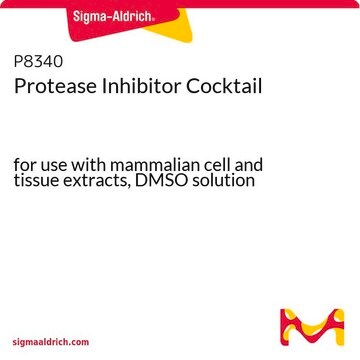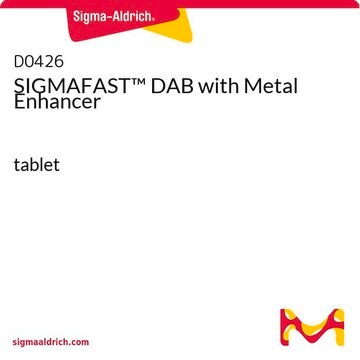This product has a shelf life of 3 years.
Kluczowe dokumenty
D5637
3,3′-Diaminobenzidine tetrahydrochloride hydrate
≥96%
Synonim(y):
(1,1′-Biphenyl)-3,3′,4,4′-tetramine tetrahydrochloride dihydrate
Wybierz wielkość
282,00 zł
Wybierz wielkość
About This Item
282,00 zł
Polecane produkty
Poziom jakości
Próba
≥96%
Formularz
powder, crystals or chunks
metody
titration: 96-104% (with NaOH)
kolor
white to light brown, and Faint Red and Faint Grey to Light Grey
mp
280 °C
rozpuszczalność
H2O: 50 mg/mL
Zastosowanie
diagnostic assay manufacturing
hematology
histology
temp. przechowywania
−20°C
ciąg SMILES
O.Cl.Cl.Cl.Cl.Nc1ccc(cc1N)-c2ccc(N)c(N)c2
InChI
1S/C12H14N4.4ClH.H2O/c13-9-3-1-7(5-11(9)15)8-2-4-10(14)12(16)6-8;;;;;/h1-6H,13-16H2;4*1H;1H2
Klucz InChI
DXWSCXIZIHILNP-UHFFFAOYSA-N
Szukasz podobnych produktów? Odwiedź Przewodnik dotyczący porównywania produktów
Powiązane kategorie
Opis ogólny
Zastosowanie
Działania biochem./fizjol.
Hasło ostrzegawcze
Danger
Zwroty wskazujące rodzaj zagrożenia
Zwroty wskazujące środki ostrożności
Klasyfikacja zagrożeń
Acute Tox. 4 Oral - Carc. 1B - Eye Irrit. 2 - Muta. 2
Kod klasy składowania
6.1C - Combustible acute toxic Cat.3 / toxic compounds or compounds which causing chronic effects
Klasa zagrożenia wodnego (WGK)
WGK 3
Temperatura zapłonu (°F)
Not applicable
Temperatura zapłonu (°C)
Not applicable
Środki ochrony indywidualnej
Eyeshields, Gloves, type N95 (US)
Wykazy regulacyjne
Wykazy regulacyjne dotyczą głównie produktów chemicznych. Można w nich podawać ograniczoną liczbę informacji na temat produktów niechemicznych. Brak wpisu oznacza, że żaden ze składników nie znajduje się w wykazie. Użytkownik odpowiada za zagwarantowanie bezpiecznego i zgodnego z prawem stosowania produktu.
EU REACH Annex XVII (Restriction List)
Wybierz jedną z najnowszych wersji:
Masz już ten produkt?
Dokumenty związane z niedawno zakupionymi produktami zostały zamieszczone w Bibliotece dokumentów.
Klienci oglądali również te produkty
Produkty
NBT-BCIP substrate system aids in western blotting and immunohistological staining, producing a blue-purple insoluble end product.
-
What is the shelf life of Product D5637, 3,3´-Diaminobenzidine tetrahydrochloride hydrate (DAB)?
1 answer-
Helpful?
-
-
Do you have a staining protocol for Product D5637, 3,3´-Diaminobenzidine tetrahydrochloride hydrate (DAB)?
1 answer-
Dissolve 10 mg in 15 mL of Tris buffered saline, pH 7.6 (Tris-buffered saline tablet, Sigma Product No. T5030 may be used). Add 12 uL of fresh 30% hydrogen peroxide (Sigma Product No. H1009) prior to use. Solution may be filtered through a 0.2 micron filter immediately prior to use if necessary. DAB and hydrogen peroxide concentrations may be adjusted to suit individual applications. The stain can be enhanced with Ni. Make up 0.3% (w/v) NiCl2 in water. Add 1 mL of the NiCl2 stock to 9 mL DAB solution.
Helpful?
-
-
What is the Department of Transportation shipping information for this product?
1 answer-
Transportation information can be found in Section 14 of the product's (M)SDS.To access the shipping information for this material, use the link on the product detail page for the product.
Helpful?
-
-
Can the solutions of Product D5637, 3,3´-Diaminobenzidine tetrahydrochloride hydrate (DAB), be filtered?
1 answer-
DAB solution may be filtered through a 0.2 micron filter immediately prior to use.
Helpful?
-
-
What is the solution stability of Product D5637, 3,3´-Diaminobenzidine tetrahydrochloride hydrate (DAB)?
1 answer-
In our experience, solutions of DAB should be made immediately prior to use for best results. If and only if necessary, solutions can be kept in the dark and refrigerated for overnight storage. Based on our Immunology Department’s experience, storing the solution overnight did not give good reproducibility. However, the literature indicates that it is possible to store solutions of DAB at -20°C. DAB dissolved in Tris buffered saline (pH 7.6) at 0.6 mg/ml was reported to be stable for several weeks at 4°C.
Helpful?
-
-
What is Product D5637, 3,3´-Diaminobenzidine tetrahydrochloride hydrate (DAB), soluble in?
1 answer-
DAB HCl is soluble in water at 50 mg/ml yielding a clear to slightly hazy solution. For consistency, it is important to allow DAB to come to room temperature before making solutions. Water quality is extremely important, so only high quality deionized or distilled water should be used to make DAB solutions.
Helpful?
-
-
How is Product D5637, 3,3´-Diaminobenzidine tetrahydrochloride hydrate (DAB), shipped and stored?
1 answer-
The product is shipped at ambient temperature. However, it is stored at -20 degrees C for long term storage.
Helpful?
-
Active Filters
Nasz zespół naukowców ma doświadczenie we wszystkich obszarach badań, w tym w naukach przyrodniczych, materiałoznawstwie, syntezie chemicznej, chromatografii, analityce i wielu innych dziedzinach.
Skontaktuj się z zespołem ds. pomocy technicznej










